The Promoting Effect of Metal Vacancy on CoAl Hydrotalcite-Derived Oxides for the Catalytic Oxidation of Formaldehyde
Abstract
1. Introduction
2. Experimental Section
2.1. Materials
2.2. Catalyst Preparation
2.2.1. Pretreatment of Nickel Foam
2.2.2. Synthesis of LDO and LDO on Ni Foam
2.2.3. Synthesis of Etched LDO and LDO on Ni Foam
2.3. Catalyst Characterization
2.4. Catalytic Activity Tests
3. Results and Discussion
3.1. Morphology and Structure
3.2. Activation Performance of Prepared Material
3.3. Surface Chemistry
4. Conclusions
Author Contributions
Funding
Institutional Review Board Statement
Informed Consent Statement
Data Availability Statement
Conflicts of Interest
References
- Wang, W.; Niu, Q.; Zeng, G.; Zhang, C.; Huang, D.; Shao, B.; Zhou, C.; Yang, Y.; Liu, Y.; Guo, H.; et al. 1D porous tubular g-C3N4 capture black phosphorus quantum dots as 1D/0D metal-free photocatalysts for oxytetracycline hydrochloride degradation and hexavalent chromium reduction. Appl. Catal. B Environ. 2020, 273, 119051. [Google Scholar] [CrossRef]
- Xu, Q.; Zhang, Y.; Mo, J.; Li, X. Indoor Formaldehyde Removal by Thermal Catalyst: Kinetic Characteristics, Key Parameters, and Temperature Influence. Environ. Sci. Technol. 2011, 45, 5754–5760. [Google Scholar] [CrossRef]
- Ye, J.; Yu, Y.; Fan, J.; Cheng, B.; Yu, J.; Ho, W. Room-temperature formaldehyde catalytic decomposition. Environ. Sci. Nano 2020, 7, 3655–3709. [Google Scholar] [CrossRef]
- Robert, B.; Nallathambi, G. Indoor formaldehyde removal by catalytic oxidation, adsorption and nanofibrous membranes: A review. Environ. Chem. Lett. 2021, 19, 2551–2579. [Google Scholar] [CrossRef]
- Zhou, H.; Zeng, Y.; Low, Z.; Zhang, F.; Zhong, Z.; Xing, W. Core-dual-shell structure MnO2@Co–C@SiO2 nanofiber membrane for efficient indoor air cleaning. J. Membr. Sci. 2023, 677, 121644. [Google Scholar] [CrossRef]
- Zhang, H.; Guo, G.; Wang, Z.; He, Q.; He, X.; Ji, H. Superior performance of formaldehyde complete oxidation at ambient temperature over Co single-atom catalysts. Appl. Catal. B Environ. 2023, 333, 122774. [Google Scholar] [CrossRef]
- Li, R.; Shi, X.; Huang, Y.; Chen, M.; Zhu, D.; Ho, W.; Cao, J.; Lee, S. Catalytic oxidation of formaldehyde on ultrathin Co3O4 nanosheets at room temperature: Effect of enhanced active sites exposure on reaction path. Appl. Catal. B Environ. 2022, 319, 121902. [Google Scholar] [CrossRef]
- Du, X.; Li, C.; Zhang, J.; Zhao, L.; Li, S.; Lyu, Y.; Zhang, Y.; Zhu, Y.; Huang, L. Highly efficient simultaneous removal of HCHO and elemental mercury over Mn-Co oxides promoted Zr-AC samples. J. Hazard. Mater. 2021, 408, 124830. [Google Scholar] [CrossRef]
- Wang, D.; Cuo, Z.; Du, Y.; Yang, W.; Zhang, M.; Chen, Y. Hierarchical NiCo2O4-MnOx-NF monolithic catalyst synthesized by in-situ alternating anode and cathode electro-deposition strategy: Strong interfacial anchoring force promote catalytic performance. Appl. Surf. Sci. 2020, 532, 147485. [Google Scholar] [CrossRef]
- Zhang, S.; Zhang, L.; Liu, L.; Wang, X.; Pan, J.; Pan, X.; Yu, H.; Song, S. NiCo-LDH@MnO2 nanocages as advanced catalysts for efficient formaldehyde elimination. Colloids Surf. A Physicochem. Eng. Asp. 2022, 650, 129619. [Google Scholar] [CrossRef]
- Sun, L.; Liu, Y.; Yan, M.; Liu, W.; Liu, X.; Shi, W. ZIFs derived multiphase CoSe2 nanoboxes induced and fixed on CoAl-LDH nanoflowers for high-performance hybrid supercapacitor. Chem. Eng. Sci. 2022, 252, 117241. [Google Scholar] [CrossRef]
- Gong, J.; Wang, X.; Dong, X.; Li, J.; Yang, F.; Yuan, A.; Ji, H. MnCo-Layered double hydroxides nanosheets supported Pd nanoparticles for complete catalytic oxidation of formaldehyde at room temperature. Appl. Surf. Sci. 2022, 606, 154702. [Google Scholar] [CrossRef]
- Trafela, Š.; Šturm, S.; Žužek Rožman, K. Surface modification for the enhanced electrocatalytic HCHO oxidation performance of Ni-thin-film-based catalysts. Appl. Surf. Sci. 2021, 537, 147822. [Google Scholar] [CrossRef]
- Zhang, G.; Zhang, X.; Meng, Y.; Pan, G.; Ni, Z.; Xia, S. Layered double hydroxides-based photocatalysts and visible-light driven photodegradation of organic pollutants: A review. Chem. Eng. J. 2020, 392, 123684. [Google Scholar] [CrossRef]
- Li, S.; Ezugwu, C.I.; Zhang, S.; Xiong, Y.; Liu, S. Co-doped MgAl-LDHs nanosheets supported Au nanoparticles for complete catalytic oxidation of HCHO at room temperature. Appl. Surf. Sci. 2019, 487, 260–271. [Google Scholar] [CrossRef]
- Jing, C.; Zhu, Y.; Liu, X.; Ma, X.; Dong, F.; Dong, B.; Li, S.; Li, N.; Lan, T.; Zhang, Y. Morphology and crystallinity-controlled synthesis of etched CoAl LDO/MnO2 hybrid nanoarrays towards high performance supercapacitors. J. Alloys Compd. 2019, 806, 917–925. [Google Scholar] [CrossRef]
- Zeng, J.; Lu, K.; Zhang, J.; Sun, Y.; Chang, Z.; Li, J.; Dai, B.; Yu, F.; Li, J.; Liu, J. Solution plasma-assisted preparation of highly dispersed NiMnAl-LDO catalyst to enhance low-temperature activity of CO2 methanation. Int. J. Hydrogen Energy 2022, 47, 2234–2244. [Google Scholar] [CrossRef]
- Xie, Z.-H.; He, C.-S.; Pei, D.-N.; Zheng, Y.-Z.; Wu, X.-Y.; Xiong, Z.; Du, Y.; Pan, Z.-C.; Yao, G.; Lai, B. Efficient degradation of micropollutants in CoCaAl-LDO/peracetic acid (PAA) system: An organic radical dominant degradation process. J. Hazard. Mater. 2023, 452, 131286. [Google Scholar] [CrossRef]
- Chen, S.; Vasiliades, M.A.; Yan, Q.; Yang, G.; Du, X.; Zhang, C.; Li, Y.; Zhu, T.; Wang, Q.; Efstathiou, A.M. Remarkable N2-selectivity enhancement of practical NH3-SCR over Co0.5Mn1Fe0.25Al0.75Ox-LDO: The role of Co investigated by transient kinetic and DFT mechanistic studies. Appl. Catal. B Environ. 2020, 277, 119186. [Google Scholar] [CrossRef]
- Chen, Y.; Fan, Z.; Zhang, Z.; Niu, W.; Li, C.; Yang, N.; Chen, B.; Zhang, H. Two-Dimensional Metal Nanomaterials: Synthesis, Properties, and Applications. Chem. Rev. 2018, 118, 6409–6455. [Google Scholar] [CrossRef]
- Zhou, N.; Yang, R.; Zhai, T. Two-dimensional non-layered materials. Mater. Today Nano 2019, 8, 100051. [Google Scholar] [CrossRef]
- Huang, M.; Chen, J.; Tang, H.; Jiao, Y.; Zhang, J.; Wang, G.; Wang, R. Improved oxygen activation over metal–organic-frameworks derived and zinc-modulated Co@NC catalyst for boosting indoor gaseous formaldehyde oxidation at room temperature. J. Colloid Interface Sci. 2021, 601, 833–842. [Google Scholar] [CrossRef] [PubMed]
- Li, Y.; Sun, P.; Liu, T.; Cheng, L.; Chen, R.; Bi, X.; Dong, X. Efficient photothermal conversion for oxidation removal of formaldehyde using an rGO-CeO2 modified nickel foam monolithic catalyst. Sep. Purif. Technol. 2023, 311, 123236. [Google Scholar] [CrossRef]
- Wang, D.; Li, S.; Du, Y.; Wu, X.; Chen, Y. Self-Templating Synthesis of 3D Hierarchical NiCo2O4@NiO Nanocage from Hydrotalcites for Toluene Oxidation. Catalysts 2019, 9, 352. [Google Scholar] [CrossRef]
- Zeng, H.; Zhu, H.; Deng, J.; Shi, Z.; Zhang, H.; Li, X.; Deng, L. New insight into peroxymonosulfate activation by CoAl-LDH derived CoOOH: Oxygen vacancies rather than Co species redox pairs induced process. Chem. Eng. J. 2022, 442, 136251. [Google Scholar] [CrossRef]
- Qiu, H.; Sun, X.; An, S.; Lan, D.; Cui, J.; Zhang, Y.; He, W. Microwave synthesis of histidine-functionalized graphene quantum dots/Ni-Co LDH with flower ball structure for supercapacitor. J. Colloid Interface Sci. 2020, 567, 264–273. [Google Scholar] [CrossRef]
- Zhao, L.-X.; Li, M.-H.; Jiang, H.-L.; Xie, M.; Zhao, R.-S.; Lin, J.-M. Activation of peroxymonosulfate by a stable Co-Mg-Al LDO heterogeneous catalyst for the efficient degradation of ofloxacin. Sep. Purif. Technol. 2022, 294, 121231. [Google Scholar] [CrossRef]
- Wang, H.E.; Chen, W.; Jin, W.; Liu, Y.L. Mn mixed oxide catalysts supported on Sn-doped CoAl-LDO for low-temperature NH3-SCR. Catal. Sci. Technol. 2023, 13, 3147–3157. [Google Scholar] [CrossRef]
- Cheng, J.Y.; Shen, B.; Yu, F.X. Precipitation in a Cu–Cr–Zr–Mg alloy during aging. Mater. Charact. 2013, 81, 68–75. [Google Scholar] [CrossRef]
- Diao, Z.P.; Zhang, Y.X.; Hao, X.D.; Wen, Z.Q. Facile synthesis of CoAl-LDH/MnO2 hierarchical nanocomposites for high-performance supercapacitors. Ceram. Int. 2014, 40 Pt B, 2115–2120. [Google Scholar] [CrossRef]
- Mo, S.P.; Li, S.D.; Xiao, H.L.; He, H.; Xue, Y.D.; Zhang, M.Y.; Ren, Q.M.; Chen, B.X.; Chen, Y.F.; Ye, D.Q. Low-temperature CO oxidation over integrated penthorum chinense-like MnCo2O4 arrays anchored on three-dimensional Ni foam with enhanced moisture resistance. Catal. Sci. Technol. 2018, 8, 1663–1676. [Google Scholar] [CrossRef]
- Sing, K.S.W. Reporting physisorption data for gas/solid systems with special reference to the determination of surface area and porosity (Recommendations 1984). Pure Appl. Chem. 1985, 57, 603–619. [Google Scholar] [CrossRef]
- Liu, Q.; Gao, J.; Gu, F.; Lu, X.; Liu, Y.; Li, H.; Zhong, Z.; Liu, B.; Xu, G.; Su, F. One-pot synthesis of ordered mesoporous Ni–V–Al catalysts for CO methanation. J. Catal. 2015, 326, 127–138. [Google Scholar] [CrossRef]
- Chen, R.; Fang, X.; Li, J.; Zhang, Y.; Liu, Z. Mechanistic investigation of the enhanced SO2 resistance of Co-modified MnOx catalyst for the selective catalytic reduction of NOx by NH3. Chem. Eng. J. 2023, 452, 139207. [Google Scholar] [CrossRef]
- Wang, Z.; Lan, J.; Haneda, M.; Liu, Z. Selective catalytic reduction of NOx with NH3 over a novel Co-Ce-Ti catalyst. Catal. Today 2021, 376, 222–228. [Google Scholar] [CrossRef]
- Feng, Y.; Liu, J.; Wu, D.; Zhou, Z.; Deng, Y.; Zhang, T.; Shih, K. Efficient degradation of sulfamethazine with CuCo2O4 spinel nanocatalysts for peroxymonosulfate activation. Chem. Eng. J. 2015, 280, 514–524. [Google Scholar] [CrossRef]
- Zeng, H.; Zhang, W.; Deng, L.; Luo, J.; Zhou, S.; Liu, X.; Pei, Y.; Shi, Z.; Crittenden, J. Degradation of dyes by peroxymonosulfate activated by ternary CoFeNi-layered double hydroxide: Catalytic performance, mechanism and kinetic modeling. J. Colloid Interface Sci. 2018, 515, 92–100. [Google Scholar] [CrossRef]
- Li, J.-R.; Wang, F.-K.; He, C.; Huang, C.; Xiao, H. Catalytic total oxidation of toluene over carbon-supported CuCo oxide catalysts derived from Cu-based metal organic framework. Powder Technol. 2020, 363, 95–106. [Google Scholar] [CrossRef]
- Zhang, W.; Díez-Ramírez, J.; Anguita, P.; Descorme, C.; Valverde, J.L.; Giroir-Fendler, A. Nanocrystalline Co3O4 catalysts for toluene and propane oxidation: Effect of the precipitation agent. Appl. Catal. B Environ. 2020, 273, 118894. [Google Scholar] [CrossRef]
- Guo, H.; Niu, H.-Y.; Wang, W.-J.; Wu, Y.; Xiong, T.; Chen, Y.-R.; Su, C.-Q.; Niu, C.-G. Schottky barrier height mediated Ti3C2 MXene based heterostructure for rapid photocatalytic water disinfection: Antibacterial efficiency and reaction mechanism. Sep. Purif. Technol. 2023, 312, 123412. [Google Scholar] [CrossRef]
- Sexton, B.A.; Hughes, A.E.; Turney, T.W. An XPS and TPR study of the reduction of promoted cobalt-kieselguhr Fischer-Tropsch catalysts. J. Catal. 1986, 97, 390–406. [Google Scholar] [CrossRef]
- Jiang, S.; Song, S. Enhancing the performance of Co3O4/CNTs for the catalytic combustion of toluene by tuning the surface structures of CNTs. Appl. Catal. B Environ. 2013, 140–141, 1–8. [Google Scholar] [CrossRef]
- Lamonier, J.-F.; Boutoundou, A.-B.; Gennequin, C.; Pérez-Zurita, M.J.; Siffert, S.; Aboukais, A. Catalytic Removal of Toluene in Air over Co–Mn–Al Nano-oxides Synthesized by Hydrotalcite Route. Catal. Lett. 2007, 118, 165–172. [Google Scholar] [CrossRef]
- An, S.; Yang, H.; Wang, J. Revealing Recurrent Urban Congestion Evolution Patterns with Taxi Trajectories. ISPRS Int. J. Geo-Inf. 2018, 7, 128. [Google Scholar] [CrossRef]
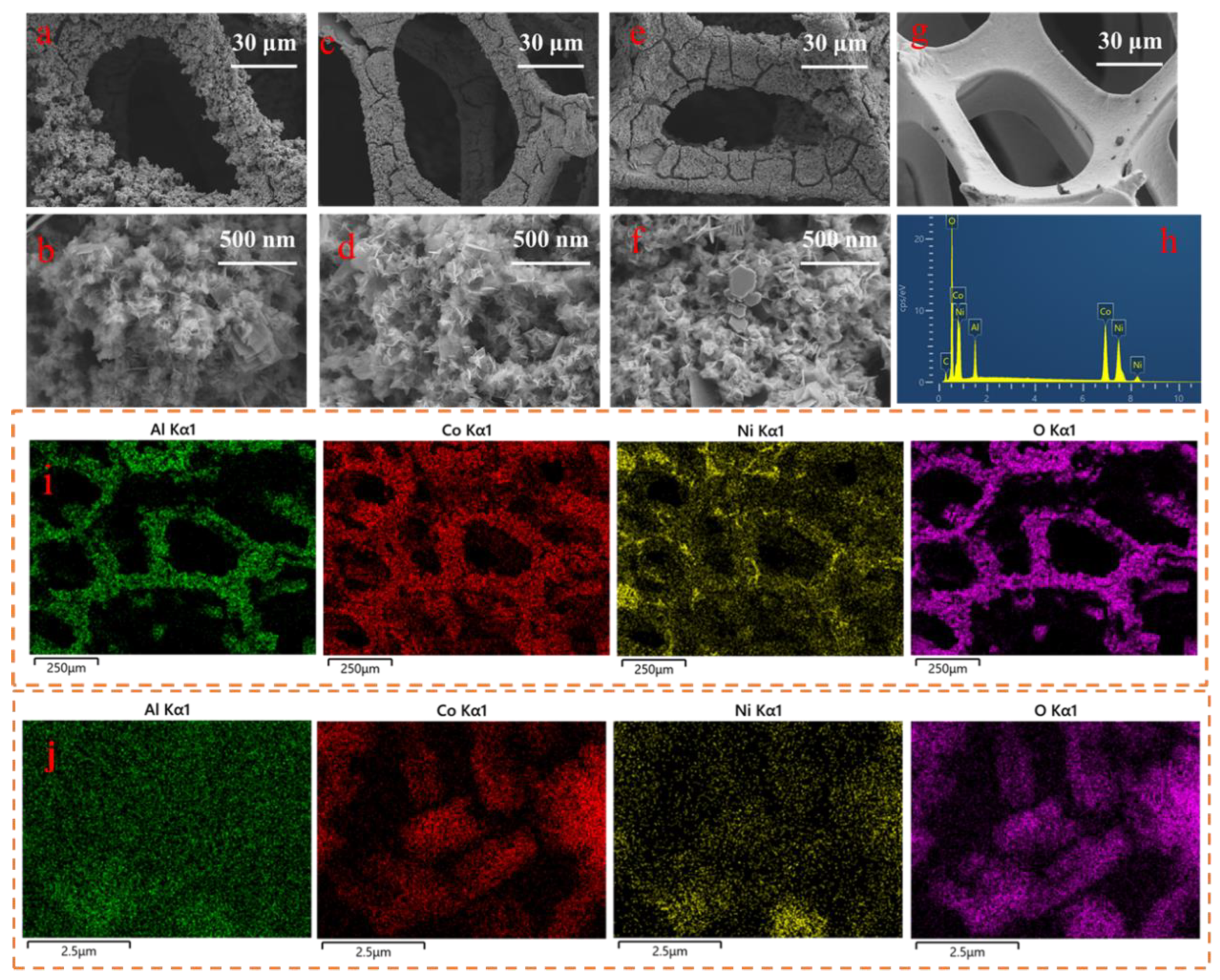
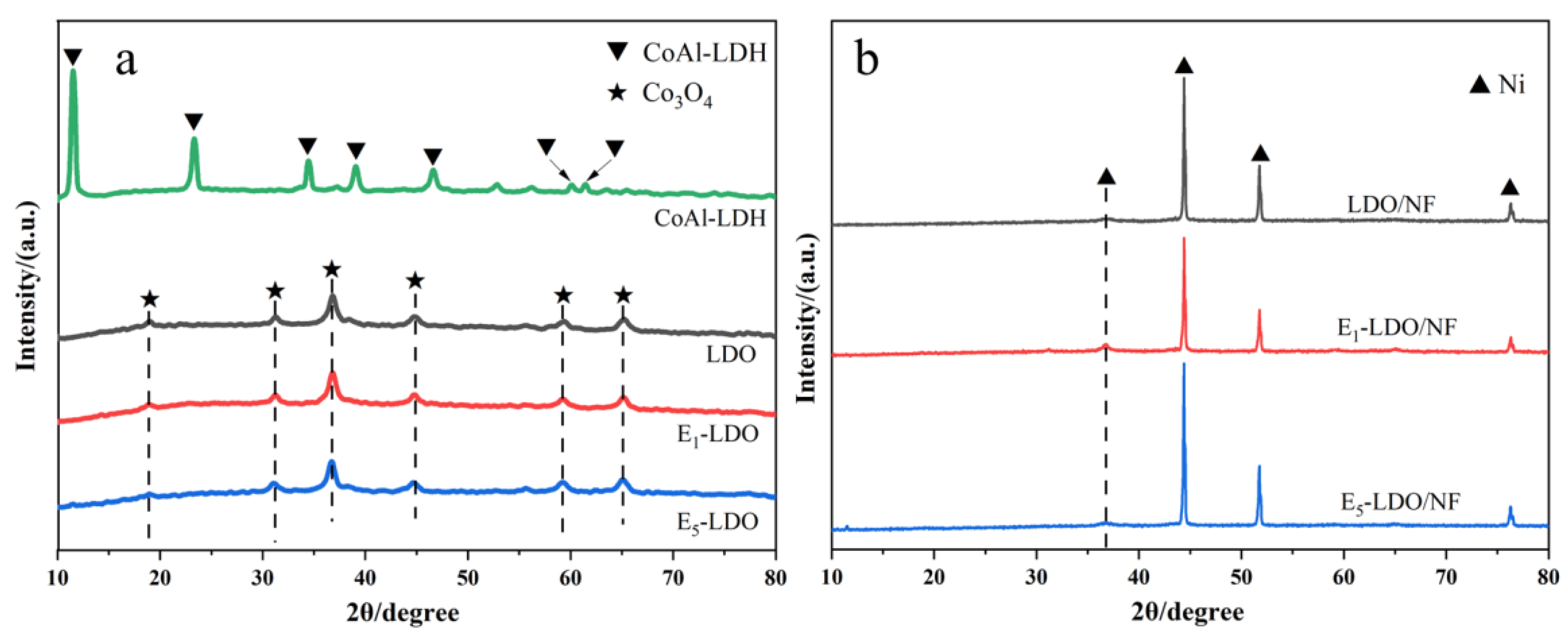
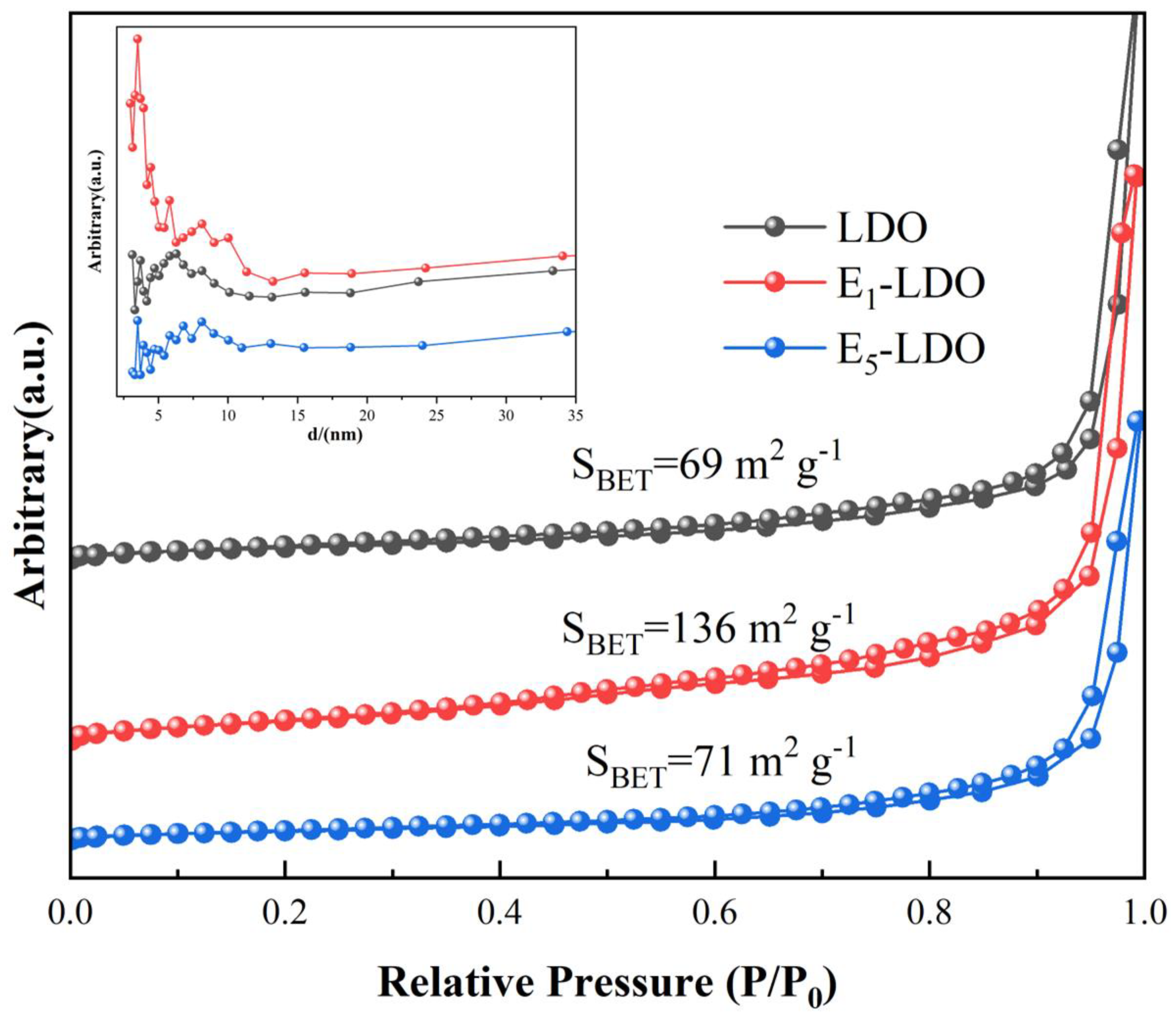
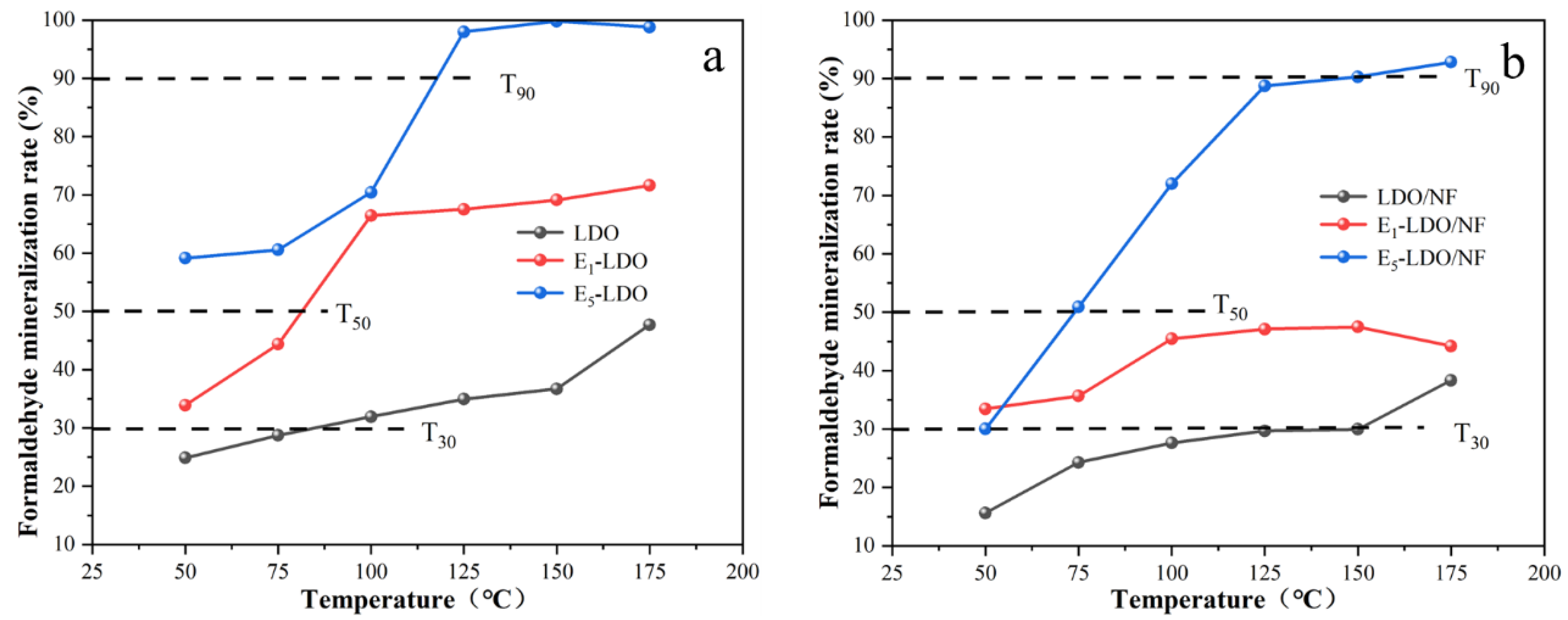

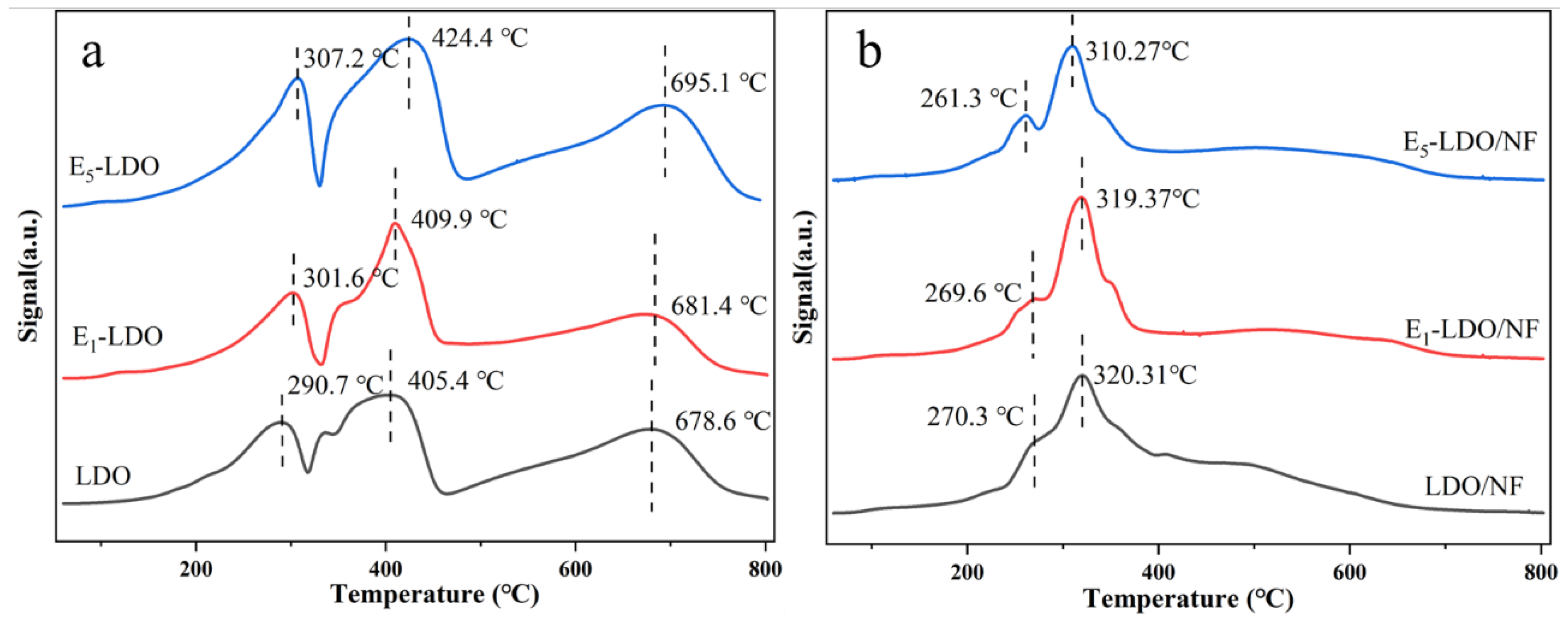

| wt% | LDO/NF | E1-LDO/NF | E5-LDO/NF |
|---|---|---|---|
| Co | 19 | 17 | 18 |
| Al | 6. | 4 | 4 |
| C | 17 | 19 | 19 |
| O | 43 | 44 | 43 |
| Ni | 15 | 16 | 16 |
| LDO | E1-LDO | E5-LDO | LDO/NF | E1-DO/NF | E5-LDO/NF | |
|---|---|---|---|---|---|---|
| Co2+/Co3+ | 97.0394 | 105.9704 | 122.922 | 100.0167 | 110.9602 | 120.4848 |
| Oads/Olatt | 90.33875 | 93.54537 | 104.5528 | 45.57956 | 125.4108 | 127.7475 |
Disclaimer/Publisher’s Note: The statements, opinions and data contained in all publications are solely those of the individual author(s) and contributor(s) and not of MDPI and/or the editor(s). MDPI and/or the editor(s) disclaim responsibility for any injury to people or property resulting from any ideas, methods, instructions or products referred to in the content. |
© 2023 by the authors. Licensee MDPI, Basel, Switzerland. This article is an open access article distributed under the terms and conditions of the Creative Commons Attribution (CC BY) license (https://creativecommons.org/licenses/by/4.0/).
Share and Cite
Chen, Y.; Zhao, S.; Gao, F.; Yu, Q.; Zhou, Y.; Tang, X.; Yi, H. The Promoting Effect of Metal Vacancy on CoAl Hydrotalcite-Derived Oxides for the Catalytic Oxidation of Formaldehyde. Processes 2023, 11, 2154. https://doi.org/10.3390/pr11072154
Chen Y, Zhao S, Gao F, Yu Q, Zhou Y, Tang X, Yi H. The Promoting Effect of Metal Vacancy on CoAl Hydrotalcite-Derived Oxides for the Catalytic Oxidation of Formaldehyde. Processes. 2023; 11(7):2154. https://doi.org/10.3390/pr11072154
Chicago/Turabian StyleChen, Yimeng, Shunzheng Zhao, Fengyu Gao, Qingjun Yu, Yuansong Zhou, Xiaolong Tang, and Honghong Yi. 2023. "The Promoting Effect of Metal Vacancy on CoAl Hydrotalcite-Derived Oxides for the Catalytic Oxidation of Formaldehyde" Processes 11, no. 7: 2154. https://doi.org/10.3390/pr11072154
APA StyleChen, Y., Zhao, S., Gao, F., Yu, Q., Zhou, Y., Tang, X., & Yi, H. (2023). The Promoting Effect of Metal Vacancy on CoAl Hydrotalcite-Derived Oxides for the Catalytic Oxidation of Formaldehyde. Processes, 11(7), 2154. https://doi.org/10.3390/pr11072154







